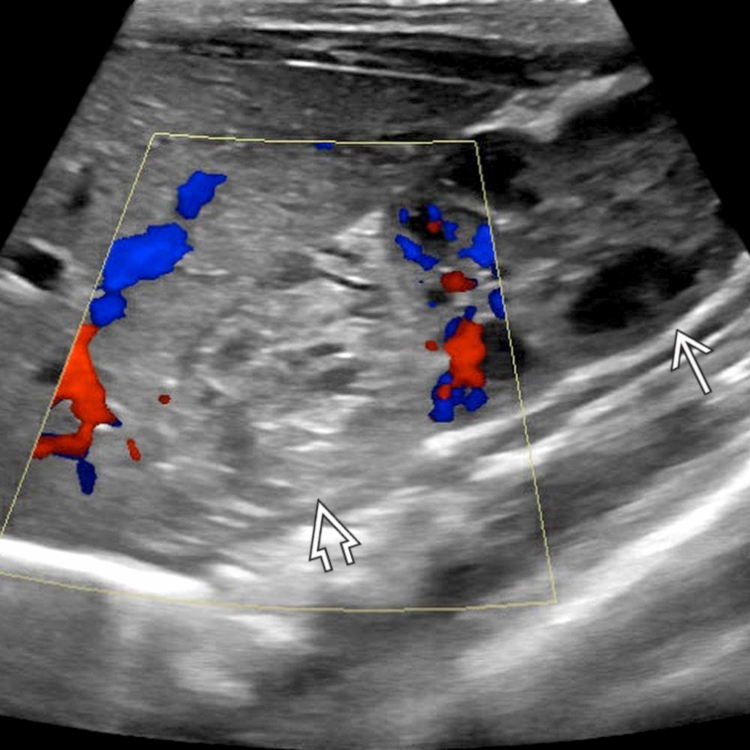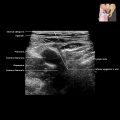KEY FACTS
Imaging
- •
Unilateral or bilateral, round or oval, well-defined mass
- •
Variable echogenicity depending on stage of hemorrhage
- •
Variable appearance depending on age of hemorrhage
- •
US: Nonspecific, avascular hypoechoic, hyperechoic, or heterogeneous lesion
- •
CT/MR: Can better characterize hemorrhagic contents of lesion, increasing specificity
- •
Acute hematoma: Hyperechoic
- •
Subacute hematoma: Mixed echogenicity ± central hypoechoic area
- •
Chronic hematoma: Hypo- or anechoic cyst-like lesion
- ○
Curvilinear calcification, internal echoes/layering debris
- ○
- •
Adreniform enlargement of adrenal gland
- •
Displacement & mass effect on kidney and IVC
- •
Avascular on color Doppler
- •
US for initial screening & detection followed by CT/MR for further characterization
- •
Left adrenal gland can be difficult to see on US, and small lesions may be obscured
Top Differential Diagnoses
- •
Adrenal adenoma
- •
Pheochromocytoma
- •
Myelolipoma
- •
Primary adrenal, metastatic, or adjacent tumors
- •
Adjacent neoplasm
- •
Adrenal lymphoma
Pathology
- •
Blunt abdominal trauma (right gland > left gland)
- •
Nontraumatic pathogenesis: Vascular dam of abundant arterial supply and limited venous drainage
- ○
Anticoagulation therapy, recent surgery, sepsis, burns, hypotension, steroids, pregnancy
- ○
Hemorrhage in primary adrenal or metastatic tumors: Pheochromocytoma, myelolipoma, adrenal carcinoma
- ○
- •
Nontraumatic pathogenesis: Vascular dam of abundant supply (3 arteries) and limited drainage (1 vein)
Clinical Issues
- •
Relatively uncommon condition but potentially catastrophic event due to adrenal insufficiency
- ○
Can result in adrenal insufficiency
- ○
- •
More common in neonates than children and adults
- ○
Most common cause of adrenal mass in infancy
- ○
Usually seen during 1st week of life
- ○
- •
Bilateral in 15% of individuals who die of shock
- •
Occurs secondary to traumatic (more common) and nontraumatic causes
- ○
Traumatic hemorrhage: Blunt abdominal trauma
- –
25% of patients with blunt abdominal trauma have adrenal hemorrhage
- –
Unilateral in 80% of cases: Right (85%), left (15%)
- –
- ○
Nontraumatic hemorrhage (often bilateral)
- –
Stress, bleeding disorders, adrenal tumors
- –
Neonatal stress (birth asphyxia), idiopathic
- –
Meningococcal septicemia (Waterhouse-Friderichsen syndrome)
- –
- ○
- •
Abdominal, flank, or back pain, nausea, and vomiting, fever, tachycardia, hypotension
- •
Acute adrenal insufficiency
- •
Waterhouse-Friderichsen syndrome: Rapidly developing adrenal failure that can lead to death
- •
Occurs in any age group but more common in neonates
Scanning Tips
- •
Left adrenal gland can be difficult to image, use spleen or fluid-filled stomach as acoustic window
 . Note right kidney
. Note right kidney  .
.










